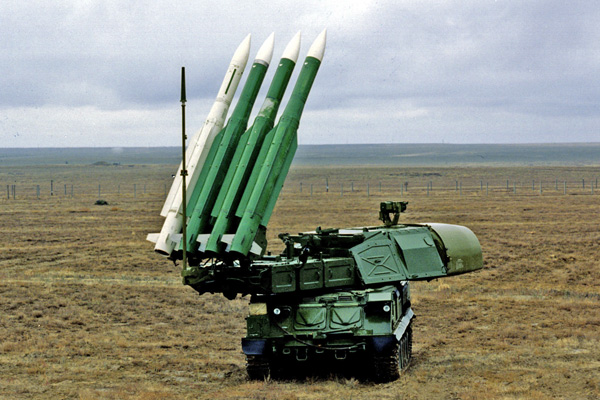
© Vladimir Zinin / ITAR-TASSBuk-M1
Passenger Boeing 777 2H6ER of Malaysia Airlines crashed in Ukraine near the village Grabovo 50 kilometers from the Russian border. All 283 passengers and 15 crew members were killed in the plane crash. Shortly after becoming aware of the accident, many sources suggested that B777 was hit by anti-aircraft missile system. Media also quoted eyewitnesses who said that Malaysian plane was shot down from the board of Su-25 by the Ukrainian Air Force.
The flightMalaysian passenger plane, registration number 9M-MRD, KLM flight KL4103, took off from Amsterdam to Kuala Lumpur at 02.14 pm Moscow time on July 17, 2014. At about 04:20 pm Moscow time, when the plane was already over the territory of Ukraine, the contact was lost with it. It is known that, approximately 50 kilometers away from the Russian border, the liner began to descend, but whether it was the cause of damage to the aircraft or change of scheduled tier before moving from one country's airspace to another, is not yet clear. Later, B777's wreckage and bodies of passengers have been found near the village of Grabovo in the Donetsk region.
According to the State Air Traffic Service Enterprise of Ukraine (the "UkSATSE") responsible for the maintenance of passenger vessels in Ukrainian airspace, the flight of Malaysian Boeing was performed in accordance with the flight rules, without any technical faults. According to the UkSATSE CEO Dmitry Babeychuk, pilots of the KLM flight KL4103 did not report any problems. The last maintenance of the liner was held on July 11, 2014. The plane was flying at an altitude of 10.6 thousand meters, which is 2.7 thousand meters higher than the height of the official curfew imposed by the Ukrainian authorities on July 8 this year.
The radius of scattered debris of the crashed Boeing 777 is at least fifteen kilometers. This suggests that the plane began to fall apart literally in the air at high altitude. The nature of the damage to be defined by analyzing the craft wreckage is yet unknown. The fact that the Malaysian liner fell on the territory of Ukraine was reported at about 07.00 pm Moscow time. Shortly thereafter, Ukraine, Russia and Ukrainian militia began to accuse each other of the crash. In particular, Russian president Vladimir Putin
blamed solely Ukraine for the accident; the president of Ukraine Petro Poroshenko accused militias; while the latter accused the official Kiev authorities.
It is interesting that both Ukrainian authorities and militia announced that the airliner was shot down by anti-aircraft missile system. Anton Gerashchenko, adviser to the Ukrainian minister of internal affairs, said that the plane was shot down by the "terrorists" who were using the "Buk anti-missile system kindly furnished to them by Mr. Putin." That complex was allegedly located near the Torez town. In turn, the RIA Novosti news agency, by citing its own sources among the militia reported that shortly before the fall of B777, the Armed Forces of Ukraine deployed a division of Buk system to the Donetsk region and started preparing for deployment of another such division to the area.
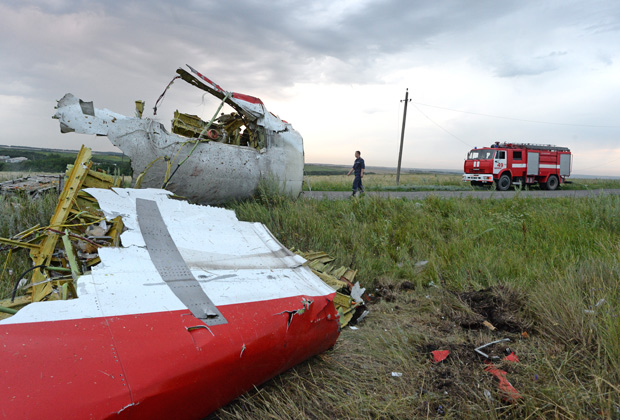
© Mikhail Voskresensky / RIA Novosti
Next day, on July 18, 2014, Russian Defense Ministry announced that 27 launchers of Buk-M1 complex of the 156th air defense missile regiment of the Armed Forces of Ukraine were deployed on the north-western outskirts of Donetsk. According to the Russian Defense Ministry, complexes of this type are capable of detecting air targets at ranges of up to 160 kilometers and hit them at all altitudes at a distance of over 30 kilometers. An indirect confirmation of the fact that Malaysian airliner was shot down by an anti-aircraft missile is a large area of debris dispersal. However, this fact cannot be used as the evidence; it requires a variety of other data to prove this version.
The BukThe version that Malaysian B777 airliner was shot down by Buk or Buk-M1 (the later versions are Buk-M1-2 and Buk-M2 were developed after the USSR collapse and were not supplied to the Ukraine) suffers a number of weaknesses, which make whole hypothesis look doubtful. According to the Ukrainian and Russian media, many people witnessed the fall of Malaysian aircraft who, among other things, stated that the plane was shot down by Su-25 bearing the Ukrainian identifying marks. The ability of the human eye to discern the type and identity of the aircraft at an altitude of ten thousand meters is out of the question, of course.
Another point is interesting here. Any Buk anti-aircraft system missile, by virtue of its design features, leaves a distinct smoke trail, which can stay visible in the air up to ten minutes. However, within several hours no testimony of such trail appeared. They began to appear only in the afternoon of July 18. In particular, the Ukrainian RKM portal
posted a photo of a smoky anti-aircraft missile trail allegedly shot at Malaysian Boeing. Reliability of that photo is unknown, but according to the RKM, it was given by Gerashchenko, who specified that the missile was launched from the third district of Torez town.
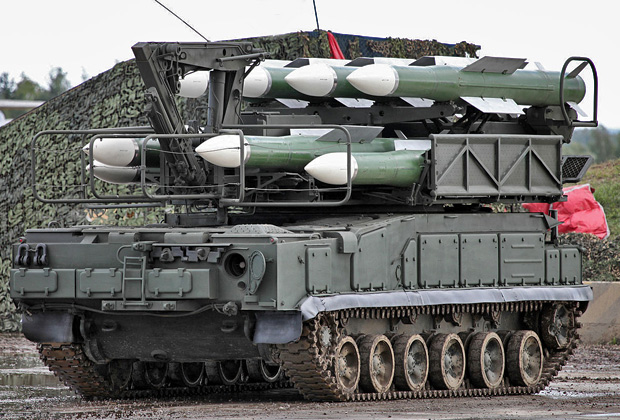
© Vitaliy Kuzmin / Wikipedia orgTEL of Buk-M1 system
It should be noted that for Buk-M1 systems capable of recognizing such targets as a plane, a helicopter or a ballistic missile, the probability of hitting a major air aerodynamic target is 60-70 percent. This is one of the reasons why at least two consecutive missile launches are required to hit an aircraft. This means that such anti-aircraft missile launch must have witnesses. The exact information on whether such launch took place can only be provided via the objective means of control, such as Voronezh-DM radar data in Krasnodar territory or control systems in the Rostov region of Russia.
In addition, the Buk-M1 complexes in their full composition, that is, together with the station for detection and targeting and a command vehicle, are capable of destroying air targets at altitudes up to 18,000 meters and at ranges up to 25 kilometers. These parameters are strongly dependent on the height and speed of the aircraft detected by the radar system. A full set of these machines are only available to the Ukrainian Armed Forces. However, if 27 launchers of Buk-M1 are located on the outskirts of Donetsk, as claimed by the Russian Defense Ministry, then the Malaysian plane was probably out of their reach.
At the end of June 2014, Donetsk militia announced the capture of A-1402 air-defense military unit. According to the Ukrainian authorities, the whole battle-capable equipment was removed from there before the capture. But militias claimed that the Buk complex came at their disposal. Later a number of photos have been published in the network showing that the Donetsk militias have at least one Buk-M1 self-propelled firing unit. It can be used as an independent combat unit to attack air targets, but without a system for detection and targeting it can only reach a height of six thousand meters maximum.
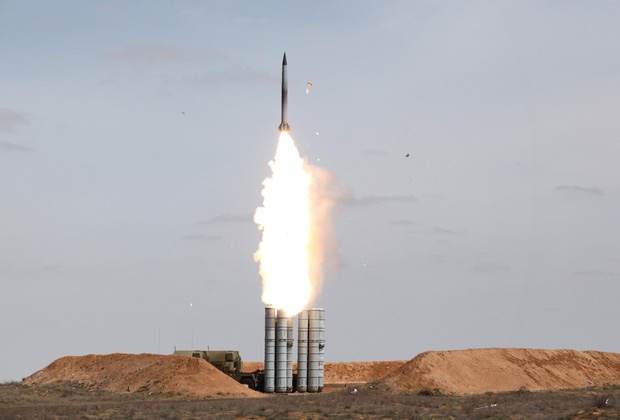
© Vladislav Belogrud / RIA NovostiLaunch of S-300PS missile
On July 18, 2014, Vitaly Yarema, the prosecutor general of Ukraine,
reported to president Poroshenko that the militias did not capture Buk or S-300 complexes and have no such weapons. According to various sources, the Ukrainian army now has 34 S-300V1/PS anti-aircraft missile complexes. Their technical characteristics allow shooting down targets at a height of more than ten thousand meters, but the positions of these complexes are fixed, and the tools to detect and classify targets allow easily distinguishing civil and military aircrafts.
In the case of C-300, if the plane was shot down by a missile of this complex, we can talk about the deliberate shelling of B777. However, in this case it is unknown where exactly the fire could come from. Meanwhile, the Russian Defense Ministry
announced on July 18, that the day before, the Russian radio equipment registered the work of Kupol radar of the Buk-M1 complex located near the Styla village. It is located about 35 kilometers from Donetsk and 80 kilometers from the Grabovo village where the Malaysian Boeing fell. Up to November 2013, Ukraine had S-200B complexes, but no reliable information about them is yet available.
ConclusionsAt present, no sufficient data is available to make at least approximate conclusions about what happened in the sky of Donetsk region. Militia
announced that they had found the flight data recorders from the board of Malaysian B777 and were willing to give them to the Interstate Aviation Committee for decryption. Flight recorders will clarify what happened onboard of the passenger liner before the disaster. Careful examination of the wreckage also will allow determining whether he was shot down. But even if the damage allows speaking about the plane being shot down by a rocket, and determining the type of rocket, it will be virtually impossible to find out where it was launched from.
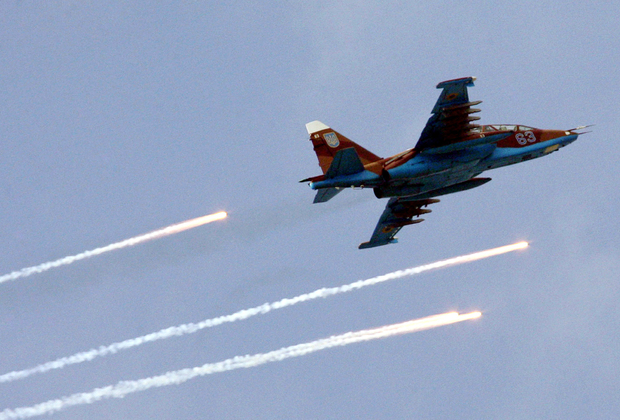
© Zhenya Savilov / ReutersA Ukrainian Air Force SU-25 fighter plane
Finally, even if it turns out that the plane was struck by a rocket, it will be absolutely impossible to determine who exactly launched it. Both Buk and S-300 complexes are equipped with the systems of combat operation parameters registration, the data from which will allow saying with a high degree of certainty whether that particular complex was used to crash the Malaysian aircraft. But the probability that the militias, Ukrainian or Russian military (according to one of the versions, the plane was shot down by Russian S-300 located in the Rostov region) will provide the international commission with access to the data from their anti-aircraft weapons, is next to zero.
The net result is that some complexes were indeed located in Donetsk area. All the rest information must be investigated by the international commission, which should be composed of representatives of all the countries concerned. Meanwhile, passenger flights over the territory of Ukraine are officially prohibited.
1. "Malaysian passenger plane, registration number 9M-MRD, KLM flight KL4103 [...]"
Rather MAS MH17.
2. "[...] complexes of this type are capable of detecting air targets at ranges of up to 160 kilometers [...]"
Way too much. As for Buk-1 and Buk-1M its radar range varies between 60=85km. The range of 160km refers to latest versions of Buk systems, which Ukies don't have.
3. "[...] many people witnessed the fall of Malaysian aircraft who, among other things, stated that the plane was shot down by Su-25 bearing the Ukrainian identifying marks."
Hardly. The service ceiling, i.e. the maximum usable altitude, of Su-25 is 7000m. Perhaps Su-27?